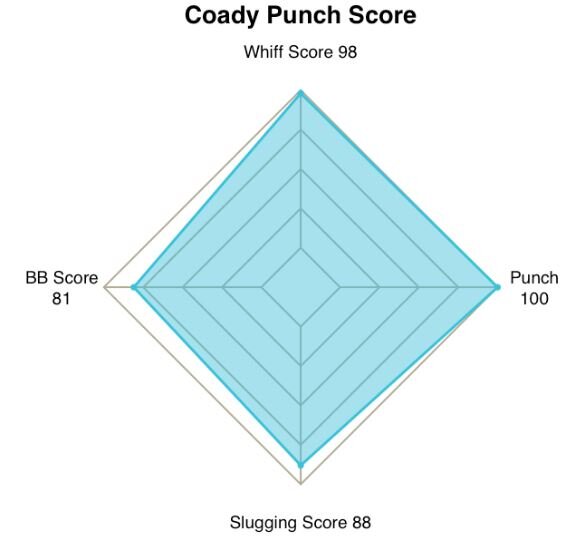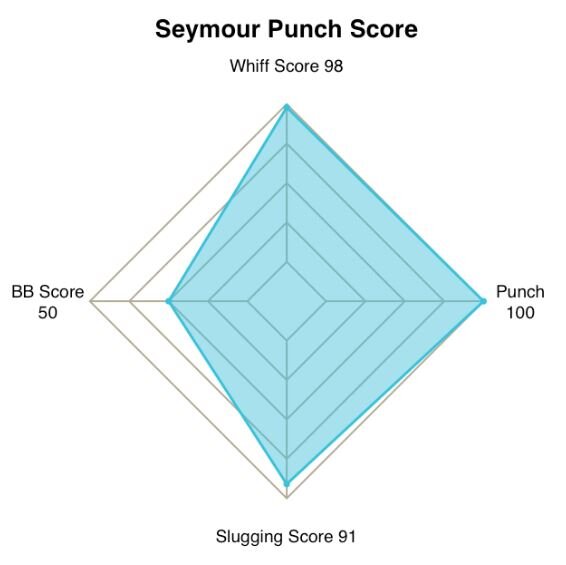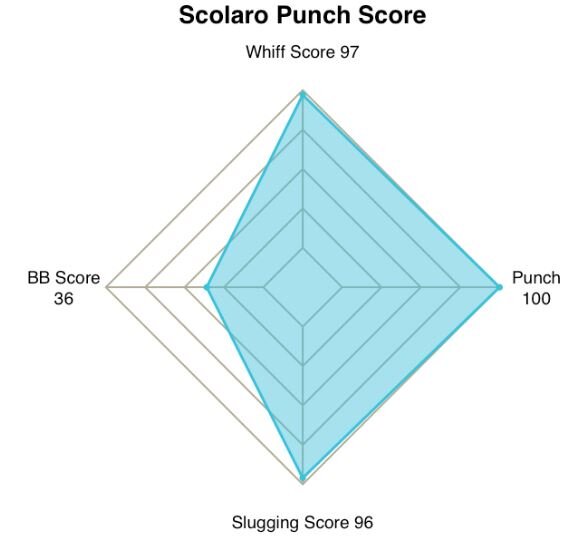In my first piece here at Prospects Live I wrote about the evaluation tool that Brandon Smith and I engineered in order to evaluate the performance and profile of a hitter, the Plate Approach Efficiency Profile. We also wanted to curate our own metric for evaluating pitchers as the Cape Cod Baseball League (CCBL) does not provide enough sample size for Stuff+ to be used on each of a pitcher’s pitches. We ended up creating a score to evaluate how a pitcher uses their arsenal to execute pitches, essentially evaluating their pitchability.
The metric is called the Punch Score. The Punch Score goes along the lines of how much of a “punch” does the pitcher pack when pitching. The Punch Score is based on the idea that a pitcher has an effective arsenal of pitches if 1) they generate whiffs 2) avoid walks 3) limit XBH. The score is strictly to give a general idea on if the pitcher can command and use their arsenal to be effective. The scale of each score is 0-100 as a range of percentiles with 100 being the best.
The math behind the Punch Score is the sum of a pitcher’s zScores for Whiff%, BB/9, and opposing SLG%. Each stat for the Punch Score is used to evaluate a small part of the pitcher’s arsenal and can be used to describe what kind of arsenal a pitcher has. Whether it is an arsenal that misses bats, limits hard contact but struggles with walks or, an arsenal that struggles to miss bats but limits walks and hard contact, we can get an idea on what kind of pitchability profile the pitcher has. The official formula for the Punch Score is shown below.
Punch = (zScored Whiff%) + (zScored BB/9) + (zScored SLG%)
With that said, below is a list and a Punch Score spider graph for the 15 pitchers with the highest Punch Scores.
Sample size note: The Punch Score compares all of the 2021 CCBL pitchers who pitched a minimum of 7 IP. Thus Punch Scores may be sensitive due to variation of IP in the CCBL.
1. Evan Shawver
Round 7 - Colorado Rockies, Harwich Mariners
Analysis: Shawver demonstrated an overall pitchability profile that shows that he has the ability to miss bats, limit walks, and generate weak contact. This profile shows that he has the capability to continue being a starter in pro ball and that he has a great foundation for further player development with his pitches.
2. Ian Villers
Round 8 - San Francisco Giants, Wareham Gatemen
Analysis: The spider chart shows that VIllers displayed the ability to throw his arsenal of pitches to generate whiffs, throw strikes, and limit hard contact. Villers shows an intriguing Punch profile that could tempt the Giants to move him out of the bullpen and stretch him out as a backend starter or continue to develop his pitches to play up in the bullpen.
3. Christian Culpepper
2022 - California Baptist University, Y.D Red Sox
Analysis: Culpepper had the highest combination of BB Score and Whiff Score out of any other pitcher in the CCBL. Shows a potential great profile as a relief pitcher due to his ability to throw strikes and get whiffs in any situation, while not being prone to hard contact.
4. Jonathan Brand
2021 - Miami University - Wareham Gatemen
Analysis: Brand has an overall well rounded pitchability profile but he stands out for his ability to limit hard contact as he is tied for 1st with his Slugging Score. Brand stands as an intriguing name to watch in the MAC in 2022.
5. Owen Coady
2022 - University of Pennsylvania - Harwich Mariners
Analysis: Coady served as the closer for Harwich and showed a dominant profile with his whiff inducing skillset. Coady was tied for 1st in the CCBL with his Whiff Score of 98 showing he has an enticing profile for a left-handed RP.
6. Daniel Federman
UDFA - Baltimore Orioles - Chatham Anglers
Analysis: Federman showed an uptick in Whiff Score during his CCBL performance compared to his season at Miami (FL). He profiles as a potential middle reliever due to his strike throwing skill set and not being elite at inducing weak contact.
7. Andrew Yancik
2021 - McKendree College - Falmouth Commodores
Analysis: Yancik’s pitchability profile is built on throwing quality strikes that generate whiffs and miss barrels. Based on pitchability and Punch alone, Yancik can be a SP or RP.
8. Carson Seymour
Round 6 - New York Mets - Harwich Mariners
Analysis: Seymour is a classic reliever type profile whose role in the backend of a bullpen will be determined by his ability to throw Ks and avoid BBs. While the Punch Score doesn’t evaluate the quality of a pitcher’s arsenal, Seymour’s graph suggests that he has power stuff due to the volatility between Whiff Score and Slugging Score.
9. Eric Adler
2022 - Wake Forest University - Bourne Braves
Analysis: Adler was a standout reliever in the CCBL and his Punch Score profile suggests he was a power reliever. Adler was tied for first with his Whiff Score of 98 showing that within his arsenal he can get the whiffs needed for a backend reliever. However, exactly the type of backend reliever Adler will be in pro ball will be determined by his development of his BB Score, as he will be on the fence of a 7th/8th inning guy vs a 9th inning type profile.
10. Jonah Scolaro
2021 - Florida State University - Hyannis Harbor Hawks
Analysis: Scolaro shows a pure RP pitchability profile. Similar to Seymour and Adler, Scolaro demonstrated the skills of a power reliever as the correlation between his Whiff Score and Slugging Score is the strongest in the CCBL.
11. Dawson Netz
2022 - University of Arizona - Orleans Firebirds
Analysis: Netz has one of the strongest base starter profiles in the CCBL due to the relationship between his BB Score and Slugging Score. He shows the potential to develop his stuff more to induce more whiffs therefore giving him more upside as a future MLB SP.
12. Brian Fitzpatrick
2021 - Rutgers University - Brewster Whitecaps
Analysis: Fitzpatrick has one of the stronger SP profiles in the CCBL. The spider chart shows that he has a very moldable profile as a pitcher and that based on pitchability alone, he can develop into many pitching roles. Obviously the true role for Fitzpatrick will be determined on the quality of his arsenal but he arguably has the most intriguing player development base in the CCBL.
13. Andre Granillo
Round 14 - St. Louis Cardinals - Cotuit Kettleers
Analysis: Granillo has a strong base pitchability profile shown by his near even split between his Whiff Score, BB Score, and Slugging Score. Depending on organizational needs and confidence in the player development operations in the Cardinals, Granillo could be pushed to develop as a RP or a backend SP. But then again the quality of a pitcher’s arsenal will be the deciding factor between the two general pitcher roles.
14. Bryce Hubbart
2022 - Florida State University - Brewster Whitecaps
Analysis: Hubbart also has a very intriguing SP profile based on his Punch distribution. He demonstrates an innate ability to miss bats and execute pitches as shown by the near even BB Score and Whiff Score. Hubbart also shows the potential to further develop his arsenal as his Whiff Score still has room to grow.
15. Trey Dombroski
2022 - Monmouth University - Harwich Mariners
Analysis: Dombroski’s base profile is ideal for a SP. His punch distribution shows that his active pitchability skillset is above average on throwing quality strikes to generate weak contact and be competitive in the strike zone. His ceiling as a SP on pitchability alone will be determined by the development of his arsenal to generate more whiffs.




















